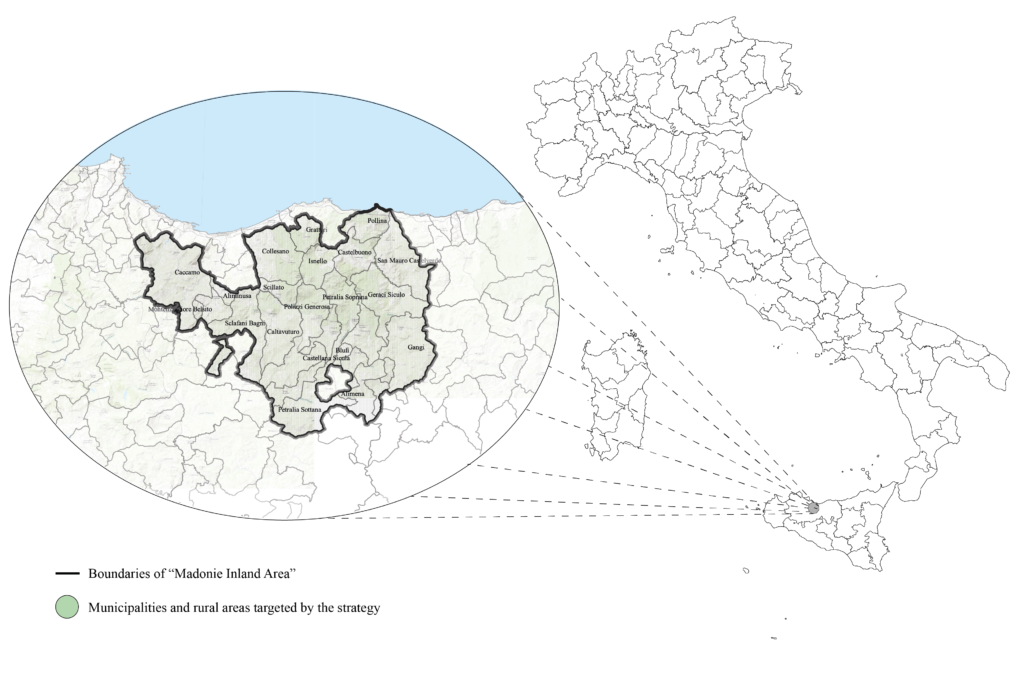This is the introductory section of a working paper focused on the regeneration of inner areas.
The specific complexity of inner areas and the need of proper methods to support the design of collaborative policies for their regeneration
Particularly in the last two decades, the population of cities has been increasing all over the world at a sustained pace. It has been estimated that eight people out of ten will live in urban areas by 2050 (European Commission 2011). Conversely, “inner areas” are experiencing a demographic decay.
This study aims to shed light on the regeneration policies for inner areas and their settled communities, whose relevance stems from a natural, cultural, and social standpoint.
Inner areas are characterized by a specific complexity: they combine rural with urban features. They may embed several municipalities where thousands of people reside. Socio-economic development in inner areas has been considered as primarily related to their capability to leverage: 1) natural resource endowments, 2) poly-centric networks of small towns distant from large cities and service hubs, and 3) a combination of innovation and tradition. In spite of such common traits, inner areas may portray even significant heterogeneities, both among the municipalities they comprise, and between them in a wider region (Barca 2014).
A major cause of inner area decline has been found in the loss of job opportunities and the consequential population decay (Tondo 2019; Istat 2019; OECD 2006) caused by the lacking mobility infrastructures (Prud’homme 2004; Baldwin and Dixon 2008; Banister and Berechman 2001; Banister and Berechman 2003) and modern services (e.g., health care, education, and ICT). To cope with such issues, regeneration and integration policies have been designed. In fact, the European Union (EU) “cohesion policy” framework set the field where different institutions (European agencies, member States, local governments, businesses, and non-profit organizations) may pursue economic, social and regional integration[1] (Begg 2010; European Commission 1996; Hooghe 1996; Hooghe and Marks 2001; Barca 2009). Through such policies, underdeveloped regions (e.g.: in Greece, Ireland, Italy, Portugal, and Spain) have primarily funded the improvement of physical infrastructures; this has led to better transportation, tourism and social services (Polverari 2016).
This policy field has been traditionally investigated under a single disciplinary perspective, encompassing Regional Economics, Urban Architecture, Sociology, and Geography.
The Italian “Agency for Territorial Cohesion” has outlined a “National Strategy for Inner Areas” (hereinafter SNAI) (OECD 2016). This strategy commits governance at different levels in the country to promote economic regeneration and foster social inclusion, possibly through the private sector involvement. For pursuing such goals, it identifies two main instruments: i) public infrastructures and services (i.e., health, education, and mobility) providing the preconditions for local development; and ii) specific projects pursuing local development in different industries (e.g., environment, culture and heritage, agriculture and food system, energy, craftmanship) (Barca 2014).
Implementing regeneration policies poses complex challenges for policy-makers (Couch 1990). Such complexity is primarily associated with a plurality of involved public and private sector organizations, whose decisions may affect outcomes over different time paths, and often according to a non-linear causality.
A leading role in addressing these issues should be taken by those municipalities that are commonly recognized as the “icons” of an area, due to their relative weight (e.g., in terms of population, land size, political power, and reputation). They should foster an interinstitutional collaboration (e.g., through municipal alliances and local development agencies) leading to consistent and sustainable policy-design. To this end, a learning process that builds on the different mental models and skills of involved actors is a prerequisite. The ideal setting for establishing collaborative strategic planning in the described context is provided by consensus-oriented decision making forums (Ansell and Gash 2007, 543). In such settings, collaboration drives joint actions, whose results cannot be attained by any organizations acting alone (Huxham et al. 2000). Therefore, performance governance should enhance the contributions provided by each organization to such achievements.
Effective implementation of collaborative forums requires proper methods to support leaders in building trust, managing conflict, and outlining robust outcome-oriented strategic planning (Crosby and Bryson 2010). Applying performance governance (Bouckaert and Halligan 2008; Van Dooren, Bouckaert, and Halligan 2015) to collaborative regimes (Emerson and Nabatchi 2015a) may align policy design at regional and agency level. In fact, participant organizations are expected to tune their plans, activities, and targets with the goals and policies outlined with other stakeholders at local area level. At the same time, effective collaborative governance requires that local area strategic plans are continuously monitored through proper performance measures, portraying the final outcomes generated by each participant organization. This is also an important part for pursuing the adaptation[2] of collaborative governance regimes through learning and mutual “knowledge transfer” (Koliba, Meek, and Zia 2011, 120).
This paper will illustrate a framework underlying a dynamic perspective to performance governance to enhance the regeneration of inner areas in cross-boundary collaboration.
Our interest in cross-boundary collaboration for inner area regeneration is driven by the relevance of such policy domain for the socio-economic development of our region, in Southern Europe. Concerning this, the design of sustainable mobility policies in the case of an Italian inner area will be framed through Dynamic Performance Governance (DPG) (Bianchi et al. 2019). The analysis of the case will illustrate how DPG may facilitate the implementation of the EU cohesion policy for the regeneration of inner areas. Since DPG is rooted on a systems approach, its application to the investigated field may also contribute to extend the disciplinary boundaries of scientific research, beyond the traditional sectoral perspectives.

[1] Since the late 1980s, cohesion policy is central for the EU integration process and takes about one third of the whole EU budget.
[2] “The notion of adaptation implies capacity to respond to change and even transform social-ecological systems into improved states” (Folke et al. 2005, 463).